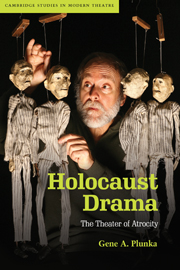Book contents
- Frontmatter
- Contents
- Acknowledgments
- 1 Introduction
- 2 Staging the Banality of Evil
- 3 Culture and the Holocaust
- 4 The Holocaust as Literature of the Body
- 5 Transcending the Holocaust
- 6 Marxism and the Holocaust
- 7 Aryan Responsibility During the Holocaust, I
- 8 Aryan Responsibility During the Holocaust, II
- 9 Heroism and Moral Responsibility in the Ghettoes
- 10 Dignity in the Concentration Camps
- 11 Holocaust Survivors in the United States and Israel
- 12 The Survivor Syndrome and the Effects of the Holocaust on Survivor Families
- 13 Holocaust Survivor Memory
- 14 The Holocaust and Collective Memory
- Notes
- Bibliography
- Index
13 - Holocaust Survivor Memory
Published online by Cambridge University Press: 01 July 2009
- Frontmatter
- Contents
- Acknowledgments
- 1 Introduction
- 2 Staging the Banality of Evil
- 3 Culture and the Holocaust
- 4 The Holocaust as Literature of the Body
- 5 Transcending the Holocaust
- 6 Marxism and the Holocaust
- 7 Aryan Responsibility During the Holocaust, I
- 8 Aryan Responsibility During the Holocaust, II
- 9 Heroism and Moral Responsibility in the Ghettoes
- 10 Dignity in the Concentration Camps
- 11 Holocaust Survivors in the United States and Israel
- 12 The Survivor Syndrome and the Effects of the Holocaust on Survivor Families
- 13 Holocaust Survivor Memory
- 14 The Holocaust and Collective Memory
- Notes
- Bibliography
- Index
Summary
History is not merely shaped by historians but is also created by Holocaust memory shared by survivors and the families of those who survived. After the war, memorials in the form of statues, museums, or concentration camp sites to honor the dead were built throughout Eastern Europe. However, as Geoffrey H. Hartman remarks, these monuments not only served to close the book on a shameful past, divesting us of the obligation to remember, but also, as profiteering, exploited and trivialized the Holocaust. Moreover, the individual angst of the Shoah became lost in these communally prescribed public rituals associated with collective memory. Collective attempts at national healing can even lead to false memory and forgetfulness. At the other extreme for many Holocaust survivors was the need to keep silent instead of commemorating the dead through monuments, for there was a strong desire to forget the trauma and to avoid being associated with a shameful past. Aharon Appelfeld commented, “So we learned silence. It was not easy to keep silent. But it was a good way out for all of us. For what, when all is said and done, was there to tell? To us as well it began to sound like something imaginary, which ought not to be believed.” However, keeping silent, as Elie Wiesel has acknowledged, only strengthens the voices that wish to deny the Shoah or those that prefer not to be reminded of its horrors.
Holocaust memory was evident after the war through testimonials and memoirs of survivors.
- Type
- Chapter
- Information
- Holocaust DramaThe Theater of Atrocity, pp. 300 - 317Publisher: Cambridge University PressPrint publication year: 2009



